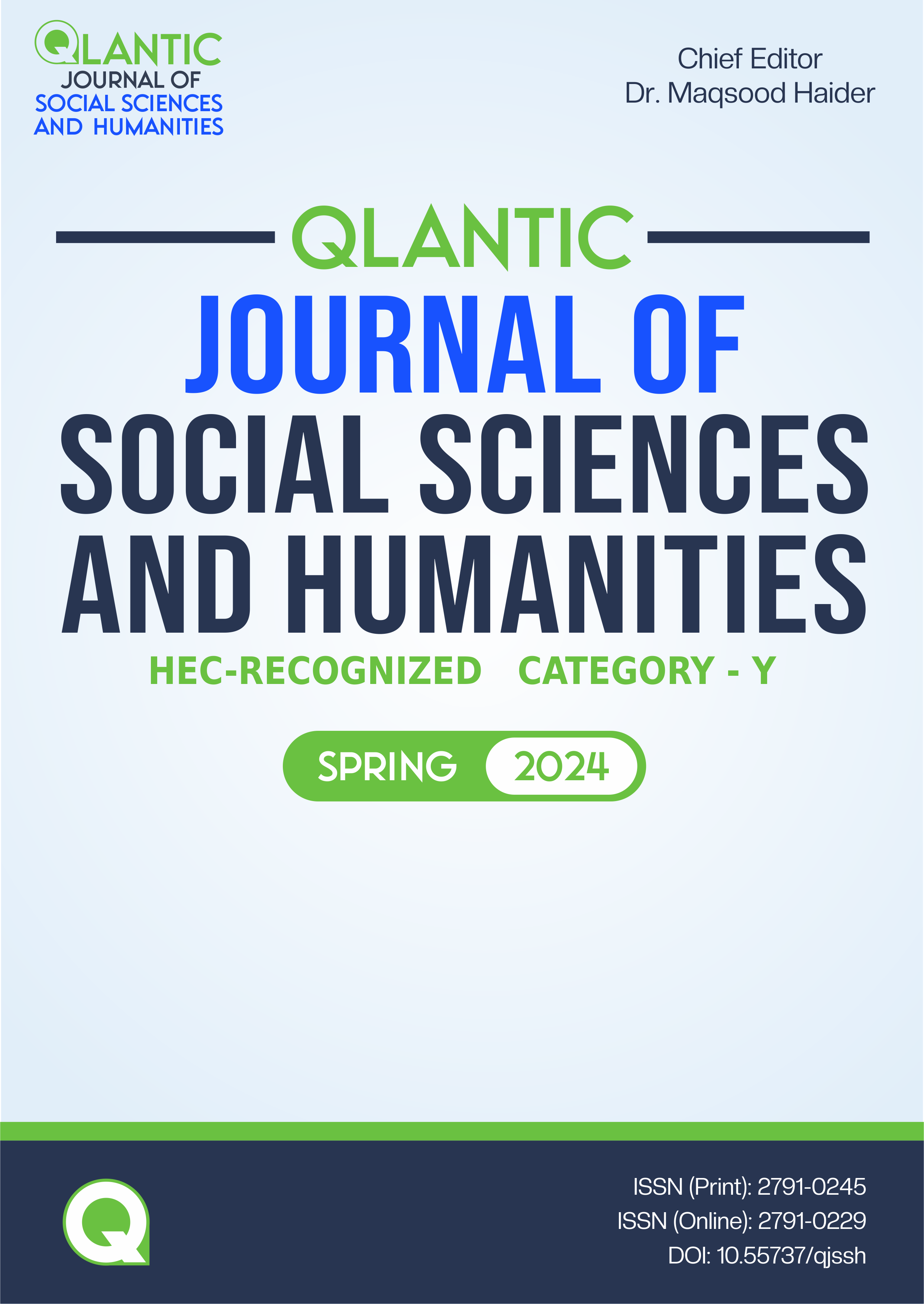Analysis of the Influence of Domestic Violence Severity on the Emotional States of Non-working Women in Sialkot
DOI:
https://doi.org/10.55737/qjssh.557194369Keywords:
Domestic Violence, Abuses, Emotional States, Non-working WomenAbstract
Violence against women is widely acknowledged as a severe violation of human rights and a significant public health issue with profound physical, mental, sexual, and reproductive health consequences. The purpose of current research is to assess the impact of domestic violence on the emotional states of non-working women. This study, using a cross-sectional quantitative approach, surveyed 350 non-working females in both rural and urban Sialkot through purposive sampling. The sample size was determined using g-power analysis. Findings revealed a strong positive correlation between domestic violence and emotional states (r=.827, p<.001; r=.771, p<.001), suggesting that increased domestic violence severity leads to greater emotional disturbance. The abusive behavior scale (r=.777, p<.001) indicated that marital abuse exacerbates domestic violence, further disturbing emotional states. In conclusion, abusive behavior moderates the relationship between domestic violence and emotional disturbance. Addressing abusive behavior is recommended to mitigate its impact on non-working women's emotional well-being.
References
Abbas, S., Zoha Batool, & Ashraf, M. (2023). Exploring the Nexus of Domestic Violence: Impact on Married Women’s Physical Health, Psychological Distress, and Magnitude of Abuse. Pakistan Journal of Humanities and Social Sciences, 11(3). https://doi.org/10.52131/pjhss.2023.1103.0612
Abbot, W. (2016). Domestic Violence Against Non-working Women. In Roberts (4th ed.). Journal of Domestic Issues. Oxford and New York: Oxford University Press.
Ahmadzad-Asl, M., Davoudi, F., Zarei, N., Mohammad-Sadeghi, H., & Rasoulian, M. (2016). Domestic violence against women as a risk factor for depressive and anxiety disorders: findings from domestic violence household survey in Tehran, Iran. Archives of Women’s Mental Health, 19(5), 861–869. https://doi.org/10.1007/s00737-016-0626-4
Aizer, A. (2011). Poverty, Violence, and Health. Journal of Human Resources, 46(3), 518–538. https://doi.org/10.3368/jhr.46.3.518
Ali, S., Majid, T., Muhammad, A., Nazish, S., Khan, W. (2017). Women’s Right and Islamic Family Law: Perspective in Reform. Pak J of Public Health, 34(9), 756-757. https://doi.org/07399332.2017.794462
Ali, T., & Gavino, I. B. (2008). Prevalence of and reasons for domestic violence among women from low socioeconomic communities of Karachi. Eastern Mediterranean Health Journal, 13(6), 1417-1426. https://doi.org/10.26719/2007.13.6.1417
Bennett, K. & Bergen, B. (2012). Intimate companion violence and negative health consequences: implications for clinicians. American Sociological Reviews 5, 328-30.
Bibi, S., Ashfaq, S., Shaikh, F., & Pir, M. A. (1969). PREVALENCE, INSTIGATING FACTORS AND HELP SEEKING BEHAVIOR OF PHYSICAL DOMESTIC VIOLENCE AMONG MARRIED WOMEN OF HYDERABAD, SINDH. Pakistan Journal of Medical Sciences, 30(1). https://doi.org/10.12669/pjms.301.4533
Crowell, J., & Sugarman, D. B. (1996). Social learning theory and family violence. In L. E. Rowley (Ed.), Handbook of family violence: Theories, intervention, and legal issues (pp. 115-130). Thousand Oaks, CA: Sage Publications.
Green, M. (2004). Domestic violence and human rights: A global perspective. In M. Flood & D. J. Maguire (Eds.), Human rights and domestic violence (pp. 1-14). Cambridge: Cambridge University Press.
Hussain, H., Hussain, S., Zahra, S., & Hussain, T. (2020). Prevalence and risk factors of domestic violence and its impacts on women’s mental health in Gilgit-Baltistan, Pakistan. Pakistan Journal of Medical Sciences, 36(4), 627–631. https://doi.org/10.12669/pjms.36.4.1530
Javed, M., Mir, S., Bibi, K., Abbas, T., Tabassum, R. (2017). Intimate partner violence among rural areas within women due to limited resources. Journal of Pakistan Medical Association, 18, 5-6.
Jones, R. F., & Horan, D. L. (1997). The American College of Obstetricians and Gynecologists: a decade of responding to violence against women. International Journal of Gynecology & Obstetrics, 58(1), 43–50. https://doi.org/10.1016/s0020-7292(97)02863-4
Joseph, A. (2020). The relationship between women's labor force participation and domestic violence in Tanzania: The role of indigeneity. Journal of Gender Studies, X(Y), 1-15.
Kalra, M. (1996). Juvenile delinquency and adult aggression against women. https://scholars.wlu.ca/etd/570?utm_source=scholars.wlu.ca%2Fetd%2F570&utm_medium=PDF&utm_campaign=PDFCoverPages
Khan, A. J., Ali, T. S., & Khuwaja, A. K. (2009). Domestic violence among Pakistani women: an insight into literature. Isra Medical Journal, 1(2), 54–56. https://ecommons.aku.edu/pakistan_fhs_son/189
Krantz, A. (2017). The impact of domestic violence on women's health: A review of the literature. Journal of Family Violence, 32(3), 335-346.
Malik, M., Sadiq, S., & Ahmed, S. (2019). Domestic violence, depression, anxiety, and quality of life among married Pakistani women. Journal of Affective Disorders, 236, 180-186.
Matud, M. P. (2005). The Psychological Impact of Domestic Violence on Spanish Women1. Journal of Applied Social Psychology, 35(11), 2310–2322. https://doi.org/10.1111/j.1559-1816.2005.tb02104.x
MOHR (2020). Understanding different forms of violence against women. https://mohrwomen.nic.in/en/understanding-different-forms-violence-against-women
Silverman, J., Murphy, R., & Valladeres, M. (2006). Domestic violence and adverse pregnancy outcomes: A review of the literature. Journal of Obstetric, Gynecologic, & Neonatal Nursing, 35(3), 306-316.
Srivastava, J. & Sharma, I. (2013).Causes of Domestic Violence in Married Women with Mental Illness: Preliminary Study. Department of psychiatry, Institute of medical sciences, Banaras Hindu,Varanasi, university, India, 1(1).
Sultan, H., Khawaja, A. O., & Kousir, T. (2016). Spousal Abuse among Pakistani Women: A Thematic Analysis. Pakistan Journal of Social and Clinical Psychology, 14(2), 33-41. https://gcu.edu.pk/pages/gcupress/pjscp/volumes/pjscp20162-5.pdf
World Health Organization. (2013). Global and regional estimates of violence against women: prevalence and health effects of intimate partner violence and non-partner sexual violence. In apps.who.int. World Health Organization. https://apps.who.int/iris/handle/10665/85239
Published
Issue
Section
License
Copyright (c) 2024 Qlantic Journal of Social Sciences and Humanities

This work is licensed under a Creative Commons Attribution-NonCommercial 4.0 International License.





